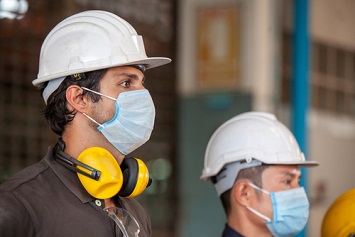It’s not a question of “if” or “when.” Whether your company fully realizes it or not, COVID-19 has already had a profound effect on the business’s organizational culture, including its safety culture. Here are some key areas of safety culture to keep an eye on to ensure that you are mitigating any negative effects the pandemic may be wreaking on your hard-won cultural successes.
With over 5 million total cases and over 175,000 deaths caused by COVID-19 in the United States, businesses across the country continue to struggle with this health and safety threat. It has taken a toll on our collective mental health, and the current atmosphere can be detrimental to safety culture. However, on the positive side, most people have developed a greater general awareness of safety and health precautions due to COVID-19.
Building a safety culture isn’t easy, and it’s important for environment, health, and safety (EHS) managers to hold the line against cultural deterioration. Focusing on the following areas can help you maintain morale and safe behaviors among your workforce.
Leadership
Good leadership is the cornerstone of safety culture, and a safety leader can come from anywhere within your organization.
- Set the example for your entire workforce. Demonstrate safe behaviors all day, every day, and show employees that caring for one another’s safety on the job is the top priority.
- Identify your allies and your champions within the organization, from the board room to the shop floor. No matter your position within the company, find the executives, managers, supervisors, and staff-level employees that you feel are on board with the organizational safety message. Support each other and build confident communications that can win over even the safety skeptics you may have within the organization.
Communication
Never underestimate the power of proper communication within an organization, and it may be more important than ever in the COVID-19 era.
- Be honest and present in your communications. Be straightforward and transparent as you let your workforce know how the organization is protecting their health and safety amid COVID-19. Make the communications as personal as possible—if you can communicate via a video call instead of a boilerplate e-mail, do so.
- Clearly set safety procedures and expectations. Reinforce your current safety policies to employees, and clearly update them on additional protocols that the pandemic may have put into place.
- Remember that communication is a two-way street. Encourage your employees to reach out with any questions or concerns that they may have regarding health and safety.
Systems, Behavior, and Engagement
With good leadership and proper communication, you can establish well-understood systems companywide, and these systems will in turn promote safe behaviors and employee engagement with safety.
- Review your management systems to see how you need to adapt. Whether you have an internal set of systems or follow international management standards, review what you have in place, make note of the adaptations you must make amid COVID-19, and take the appropriate actions. And if you don’t have a system, there’s no better time to build one than now!
- Educate employees on safe behaviors. Train your workforce on your systems, and provide them with accurate information that will help keep them and their coworkers safe.
- Demonstrate a positive outlook on safety. As you adapt your systems and train to them, never treat this process like it’s a chore—if you set a positive example of safety engagement, your employees will follow suit.
Stay Healthy, Stay Safe
COVID-19 has presented the greatest health and safety challenge many of us have faced in our EHS careers. With a well-organized, fact-based, and empathetic approach to the challenge that also employs all of the safety tools we have at our disposal, organizations can maintain healthy safety cultures even in the midst of a worldwide pandemic.

